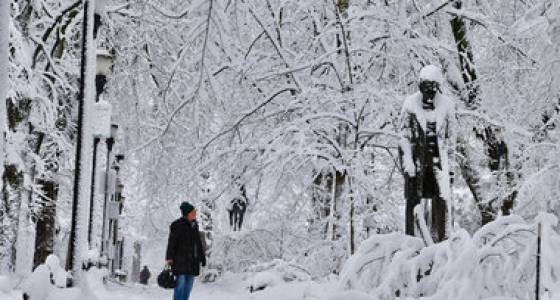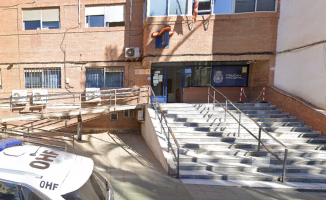They might be remembered as the eight winter events that shook our world.
From an early December snowfall to mid-January freezing rain and six storms in between, Portland-area residents experiencing winter 2016-17 may have felt like a fighter who'd taken one too many pops to the head. Snow, freezing rain, snow, more snow, trace of snow, freezing rain, blizzard and freezing rain. It has seemed relentless.
The metro area's winter lacked only the Four Horsemen of the Apocalypse and a swarm of locusts. From booming business at the Huckleberry Inn in Government Camp to the collapsed onion sheds of eastern Oregon to the snowy slopes of Astoria, the season's been one people won't soon forget.
"This year has been unusual," said Miles Higa, meteorologist with the National Weather Service in Portland.
But Higa and other weather authorities dismissed the notion this winter represents anything other than an anomaly, particularly for this season's robust snowpack in the Cascades. An Oregon State University study published this week underscored that outlook, predicting low snowpacks similar to 2013-14 and 2014-15 should be expected in the future.
Portland's seven coldest Januarys A really cold January was one of the superlatives of Portland's winter of 2016-17. It ranks seventh. By average temperature for the month, according to the Portland office of the National Weather Service: 1. 1950 27.0 2. 1949 27.7 3. 1979 30.7 4. 1957 31.2 5. 1969 31.9 6. 1943 33.2 7. 33.5 2017Winter slams in
Perhaps a rare coastal tornado sweeping through Manzanita in mid-October should have been a signal that out-of-the-ordinary weather lay ahead.
A more telling weather feature has been the jet stream. The rapidly moving ribbon of air 6 to 9 miles above the Earth "sets up the big picture," Higa said.
"Ever since we started December until now," the weather service forecaster said, "the jet stream over the Pacific Northwest has been strong and persistent in its location."
Colder winter temperatures than typical have turned precipitation into snow, freezing rain and sometimes even graupel -- the supercooled water droplets that freeze onto falling snowflakes.
In addition to snow and freezing rain, January also might be remembered for its average temperature of 33.5 degrees - the coldest January since 1985, and the seventh coldest in the city's history.
January's weather events also were remarkable for their targeted dumping.
On Jan. 10 "we had a very localized heavy snow," said weather service hydrologist Andy Bryant. "Like a lot of these snow events this winter, we'd see one in a span of 50 miles. You'd go from heavy snow to almost no snow."
Bryant pointed to Feb. 5 -- Super Bowl Sunday. The weather service predicted huge amounts of precipitation could mean 12 inches of snow by the Monday morning commute. But with temperatures in the mid-30s, the Portland area only saw massive rain.
But "if you went up to Scappoose and Longview" or Seattle, "they had several inches of snow," Bryant said.
Portland's remarkable winter of 2016-17Mounds in the mountains
Like the previous winter, snow depths on Cascade peaks have generally been at or above normal. It remains to be seen whether early rain and warming temperatures will negate some of this season's snowpack like it did last year.
But so far so good for this season, said Julie Koeberle, a hydrologist with the USDA Natural Resources Conservation Service.
"It's really exciting to see a good snow year," Koeberle said, "and we're just hoping it continues."
The OSU study, however, warns that low snowpack years of 2013-14 and 2014-15 seasons will be more common in the future. The study, published in the journal The Cryosphere, predicts the low snowpack season of 2013-14 could take place every four to five years and extremely low snowpack season of 2014-15 may happen once a decade.
"We set out to learn whether they were just off years, or if they would be likely to happen more often with increased warming," said lead author Eric Sproles, who conducted much of the research as an OSU doctoral student with funding from the National Aeronautics and Space Administration and the National Science Foundation. "Unfortunately, the data show these will become more commonplace."
For this season, however, the good times roll at ski areas.
"It's been amazing," Pera Rogers said, as yet another snow shower descended on Government Camp this week.
Rogers is the wife of Ed Rogers, manager of the Huckleberry Inn, the dining lodge that turned 50 years old this year.
"In 2015 we didn't even have huckleberries because there wasn't enough water," Pera Rogers said, referring to the low snowpack that year.
This season has been more like the heavy snow year of 2008, she said, when shoveling the roof seemed a daily duty.
Top 10 coldest Portland winters If the pattern holds, Portland's winter of 2016-17 will rank as the fifth coldest in the city's history at 36.8 degrees, through Thursday, according to the Portland office of the National Weather Service. The seasonal average is 41.7. Here's the current top 10, based on Dec. 1 through the end of February: 1. 1948 34.9 2. 1949 35.6 3. 1978 36 4. 1968 36.2 5. 1956 37.7 6. 1951 38.2 7. 1955 38.4 8. 1984 38.4 9. 1992 38.6 10.1959 39.0Problems pile up
For all of its recreational qualities, the snow also has brought complications such as ravaged roads. The Portland Bureau of Transportation announced a pothole patch-a-thon, a good-humored program to deal with the gouged asphalt from chained tires and frozen streets, among other things.
And Portland-area school districts lost multiple instruction days. Districts have differed on how to make up those hours. Portland Public Schools has not yet given out its makeup plan as it works out details with the teachers union.
The uncertain school calendar has caused havoc for families.
Portland schools not yet declaring the last day of school is "incredibly frustrating," said Julia Silverman, editor of PDX Parent and the mother of two students. "We need to know ... they owe us some information."
As for those off days, Silverman said, "The kids start to go stir crazy when they're stuck inside for so long. There are only so many cookies you can bake, so many puzzles you can work, so much TV you can monitor."
Indeed, if people did not previously have an opinion about snow -- about whether they like it or despise it, or whether it really is smart to keep chains in the trunk, or whether moving to Minnesota to take advantage of the lower real estate prices still makes sense, or whether the words "snow day" should be cause for joy or terror -- they likely do now.
Other areas of Oregon have also seen uncommon winter sights.
Astoria had 2 to 5 inches of snow Feb. 6. While snow falls perhaps twice a winter in the historic city, it rarely accumulates to such a depth.
At Crater Lake National Park, "so far this year we've received more snow than last year," said spokeswoman Jennifer Evans.
Average snow depth at the park in February is about 100 feet, and it has been at or above average since late November. Last year, the depth went above average in mid-December and dropped below average by mid-February. And in 2015, at its deepest point, the depth barely reached 50 feet.
Perhaps no other corner of Oregon has been hit as hard as Malheur County, the center of the state's onion-growing industry. Accumulated snow and ice have crushed the roofs of dozens of large storage warehouses that house harvested onions, damaging or obliterating the crop and wiping out the building.
Perhaps 60 buildings, each valued at up to $1 million, were destroyed, said Paul Skeen of Nyssa and president of the Malheur County Onion Growers Association. An estimated 115 million to 150 million pounds of yellow and red onions have been compromised.
The situation is similar across the Payette River in Idaho, which together with Oregon supplies at least a quarter of the nation's onions. Gov. Kate Brown and Idaho Gov. Butch Otter recently took a helicopter tour of the damaged areas.
Malheur County has had 44 inches of snow this winter, Skeen said. The previous record was 26 inches, and a normal winter is 12 inches.
"There's a lot of people here who didn't have the correct insurance," he said. "I don't think anything can be built back on those (sites)."
Hood River also has been hit especially hard, said Bryant, the hydrologist. By late January, the city had up 45 inches of snow and 2 inches of ice accumulation, both well above normal.
Top 10 Portland snowy winters Portland's winter of 2016-17 is on the outside looking in at the Top 10 snowiest seasons, from Dec. 1 to the end of February, according to the Portland office of the National Weather Service. Through Thursday, 11.2 inches of snow had fallen in the city, only good enough for 11th place in the hit parade. 1. 1949 43.7 2. 1968 34.0 3. 2008 23.9 4. 1948 23.0 5. 1942 19.3 6. 1992 14.1 7. 1994 13.1 8. 1955 12.4 9. 1979 12.4 10. 2003 11.7Storm's a-brewin'
Could any of this have been predicted? Sort of.
Each October, the Oregon Chapter of the American Meteorological Society convenes a handful of forecasters to offer predictions about the approaching winter. The crowd-pleasing denouement of each forecaster's prognostication was the likelihood of snow.
A few called for two snow events in the Portland area - daring predictions for a region that sometimes goes through a winter with none.
But Kyle Dettmer, hydrologist-meteorologist with the Columbia River Inter-Tribal Fish Commission, bravely went further out on the frozen ice pond.
"Expect four events," in December through February, Dettmer wrote on his presentation slide.
Dettmer predicted two events would be moderate - 3" in depth - and two minor.
Two moderate and two minor?
Edging even further out onto the ice pond of weather predictions would have been a safe bet in 2016-17.
--Allan Brettman
abrettman@oregonian.com
503-294-5900
@allanbrettman
Our editors found this article on this site using Google and regenerated it for our readers.












